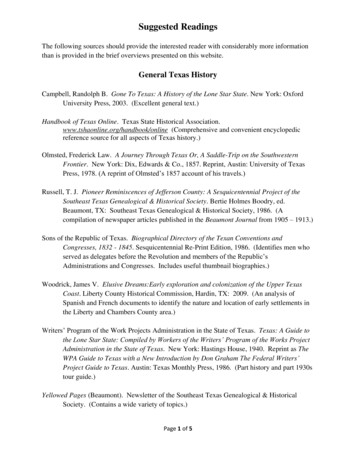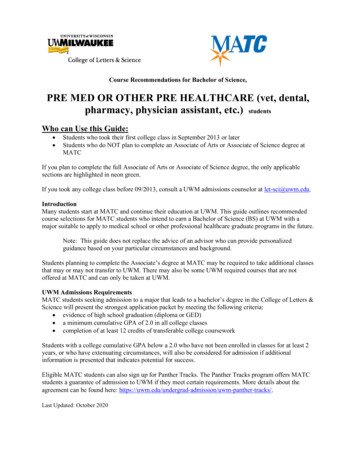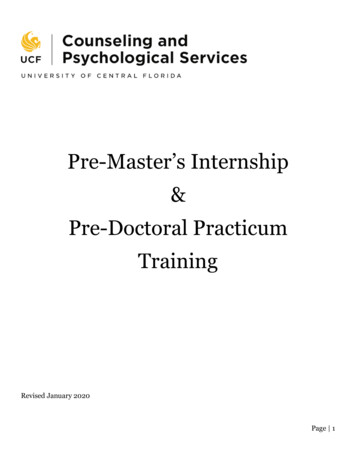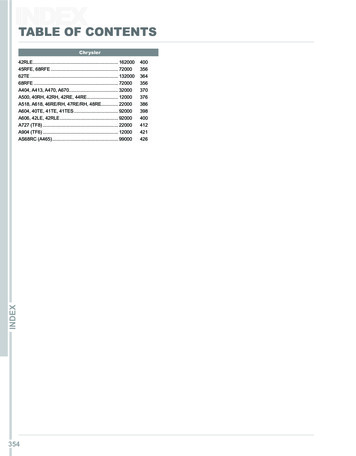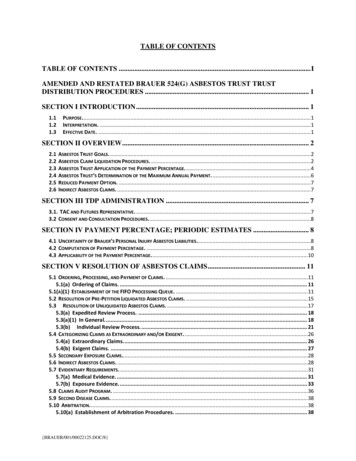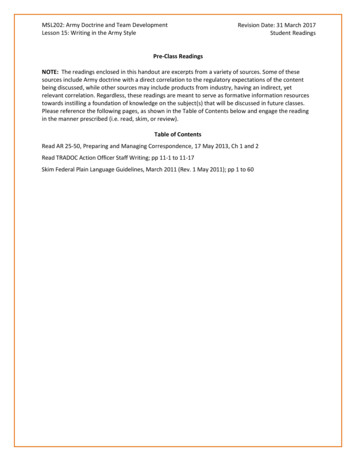
Transcription
MSL202: Army Doctrine and Team DevelopmentLesson 15: Writing in the Army StyleRevision Date: 31 March 2017Student ReadingsPre-Class ReadingsNOTE: The readings enclosed in this handout are excerpts from a variety of sources. Some of thesesources include Army doctrine with a direct correlation to the regulatory expectations of the contentbeing discussed, while other sources may include products from industry, having an indirect, yetrelevant correlation. Regardless, these readings are meant to serve as formative information resourcestowards instilling a foundation of knowledge on the subject(s) that will be discussed in future classes.Please reference the following pages, as shown in the Table of Contents below and engage the readingin the manner prescribed (i.e. read, skim, or review).Table of ContentsRead AR 25-50, Preparing and Managing Correspondence, 17 May 2013, Ch 1 and 2Read TRADOC Action Officer Staff Writing; pp 11-1 to 11-17Skim Federal Plain Language Guidelines, March 2011 (Rev. 1 May 2011); pp 1 to 60
Chapter 1Preparing CorrespondenceSection IGeneral1–1. PurposeThis regulation prescribes Department of the Army (DA) policies, procedures, and standard formats for preparing andprocessing Army correspondence.1–2. ReferencesRequired and related publications and prescribed and referenced forms are listed in appendix A.1–3. Explanation of abbreviations and termsAbbreviations and terms used in this regulation are explained in the glossary.1–4. Responsibilitiesa. Administrative Assistant to the Secretary of the Army. The AASA will—(1) Establish policies and procedures for preparing correspondence on behalf of the Secretary of the Army (SA).(2) Develop policy and direction for correspondence management for DA.b. Deputy Chief of Staff, G–3/5/7. The DCS, G–3/5/7 will incorporate effective Army writing into training coursesand fund any special requirements.c. Headquarters, Department of the Army principal officials and commanders or heads of Army commands, Armyservice component commands, direct reporting units, installations, activities, and units. HQDA principal officials andcommanders or heads of ACOMs, ASCCs, DRUs, installations, activities, and units will supervise and managecorrespondence within their agencies or commands and will actively support effective Army writing by enforcingprescribed standards for all Army personnel.1–5. Restrictions to this regulationThis regulation has been made as complete as possible to avoid issuing additional instructions. The formats forcorrespondence outlined in this regulation take precedence over format instructions outlined in other regulations ordirectives. Therefore, command publications issued to augment this regulation will be restricted to instructions that areunique to the issuing command.Note. When preparing correspondence for signature by the Secretary of Defense, SA, Chief of Staff of the Army, Under Secretary ofthe Army, Vice Chief of Staff of the Army, Assistant Secretaries of the Army, AASA, and other HQDA principal officials, followthe guidance in DA Memo 25–52 and Department of Defense (DOD) 5110.04–M.1–6. ObjectivesThe objectives of this regulation are to—a. Provide clear instructions for preparing correspondence.b. Reduce the cost of preparing correspondence.c. Standardize the preparation and dissemination of correspondence.Section IIGeneral Correspondence Guidance1–7. Methods of communicationa. Personal or telephone contact. Conduct official business by personal contact, telephone, or Defense SwitchedNetwork (DSN) whenever possible and appropriate. Use a memorandum for record (MFR) to document any decisionsor agreements reached during voice communications (see para 2–7 for the proper use of an MFR).b. Memorandum. Use the memorandum for correspondence within a department or agency, as well as for routinecorrespondence to Federal Government agencies outside DOD. Do not use the memorandum format when corresponding with the Families of military personnel or private businesses (see para 2–2 for the proper use of the memorandum).c. Letter. Use the letter for correspondence addressed to the President or Vice President of the United States,members of the White House staff, Members of Congress, Justices of the Supreme Court, heads of departments andagencies, State Governors, mayors, foreign government officials, and the public. You may also use letters to addressindividuals outside the department or agency when a personal tone is appropriate, such as in letters of commendationor condolence (see para 3–2 for the proper use of a letter).d. Electronic mail. Use email to transfer organizational and individual information.e. Army Knowledge Online and Defense Knowledge Online. Use instant messaging as an alternate method to transferAR 25–50 17 May 20131
organizational and individual information, facilitating communications with offices in multiple or distant locations. Usean MFR to document any decisions or agreements reached during instant messaging communications.1–8. Direct communicationsSend correspondence as directly as possible to the action office concerned (see para 2–4a(5)). Include the actionofficer’s name and office symbol when addressing correspondence.1–9. Routing through channelsa. Routing action correspondence. Route correspondence through commands, agencies, or offices expected toexercise control or take action.b. Bypassing intermediate headquarters. Do not route correspondence through a headquarters that has no interest orconcern in the matter or action. However, send a copy of the communication and referral action to the command,agency, or office that was bypassed. Routine correspondence may bypass intermediate headquarters when—(1) It is apparent the intermediate headquarters is not concerned.(2) No action is required.(3) No controls need to be exercised.c. Using technical channels. Use technical channels to route correspondence that deals with technical matters. Thisincludes technical reports, instructions, or requests for information that do not involve command matters. Before usingtechnical channels, make sure the action should not be sent through command channels. Do not use “FOR THECOMMANDER” on the authority line of technical channel correspondence.1–10. Writing qualityIn accordance with Public Law (PL) 111–274 (Plain Writing Act of 2010), DA writing will be clear, concise, andeffective. Army correspondence must aid effective communication and decisionmaking. The reader must be able tounderstand the writer’s ideas in a single reading, and the correspondence must be free of errors in substance,organization, style, and correctness (see para 1–37). Use electronic spell check when available but always proofread;spell check is only a tool and is not infallible.1–11. Exclusive For correspondencea. Using. Use Exclusive For correspondence for matters of a sensitive or privileged nature directed to a specificparty or parties. Minimize its use to avoid delay of action if the named addressee is absent or unavailable to receiveand act on the correspondence. Prepare Exclusive For correspondence in either letter or memorandum format.b. Addressing. Address Exclusive For correspondence to the name and title of the addressee.c. Handling. When preparing Exclusive For correspondence, place it in a sealed envelope. Type and underline thewords Exclusive For on the envelope. Distribution center and official mailroom workers will give this type of mail toaddressees unopened unless security conditions dictate that they open the mail as part of the official mail screeningprocess.Section IIISpecific Correspondence Guidance1–12. Dissemination of command instructionsUse the acronym ALARACT (all Army activities) only in electronically transmitted messages. This acronym assignsresponsibility for distribution instructions. Do not use it when addressing Army correspondence.1–13. Unique capitalizationThe following is a selection of style and usage preferences for internal Army correspondence:a. Capitalize the word “Soldier” when it refers to a U.S. Army Soldier.b. Capitalize the word “Family” when it refers to U.S. Army Family or Family members.c. Capitalize the word “Civilian” when it refers to DA civilians and is used in conjunction with Soldier and/orFamily.1–14. Abbreviations, brevity codes, and acronymsa. Memorandums. Use abbreviations and brevity codes authorized in AR 25–52 for memorandums. Use theU.S. Government Printing Office Style Manual and standard dictionaries for abbreviations not in AR 25–52. Prescribing regulations for various technical fields also provide authorized abbreviations, brevity codes, and acronyms.Abbreviated military grades are authorized for memorandums. General officers will use their full military grades on allcorrespondence.b. Letters. Use only common abbreviations found in standard dictionaries. Do not use military abbreviations, brevity2AR 25–50 17 May 2013
codes, acronyms, or military jargon in letters addressed to persons outside DOD. Military personnel will use their fullgrades (for example, lieutenant general, major general, captain, and sergeant first class) in letters.c. Abbreviation guidelines.(1) Established abbreviations are acceptable in all but the most formal writing. For reading ease, use only wellknown abbreviations or those you believe the recipient knows.(2) When a title or complete term will be used repeatedly in a document, use a shortened version of the title or terminstead of an acronym; for example, instead of “military interdepartmental purchase request,” use “purchase request.” Ifthe complete title or term is lengthy, complex, or not well known, place the abbreviated form in parentheses after thefirst time the title or term is used. Thereafter, use only the shortened form. Do not use this method if the term will notbe used repeatedly. Avoid beginning a sentence with an abbreviation or using them in the subject line, except forwords like “Mr.,” “Dr.,” “Ms.,” and so on.(3) For further guidance on correct capitalization when spelling out an abbreviation, refer to the U.S. Army RecordsManagement and Declassification Agency’s Web site, p andJoint Publication (JP) 1–02 at http://www.dtic.mil/doctrine/dod dictionary/index.html.d. Acronym guidelines.(1) Use military and civilian acronyms in memorandums, if appropriate. Do not, however, use military acronymswhen writing to individuals or organizations not familiar with their use. When an acronym is used, spell out theacronym the first time it is used and follow it with the acronym in parentheses. Thereafter, use the acronym. Do notoveruse acronyms.(2) For further guidance on correct capitalization when spelling out an acronym, see AR 25–52, the RecordsManagement and Declassification Agency’s Web site, p, and JP1–02 at http://www.dtic.mil/doctrine/dod dictionary/index.html.1–15. Letterheada. Letterhead identifies the originating organization and provides the complete standardized mailing address.b. Computer-generated letterhead is used for all official correspondence. For further guidance on using letterhead,see AR 25–30 and DA Pam 25–40.1–16. PaperPaper used for Army correspondence generally will be the standard size (81 2 by 11 inches). Use computer-generatedletterhead for the first page of all memorandums and letters except when an approved form is prescribed. Use plainwhite paper for continuing pages.1–17. Type fonts and sizesWhen creating official correspondence, use type fonts and sizes that make the correspondence easy to read andunderstand. The following guidelines will provide the best results:a. A font with a point size of 12 is recommended.b. Preferred type font is Arial.c. Unusual type styles, such as Script, will not be used in official correspondence.1–18. Ink colorCorrespondence may be signed in blue or black ink. Black ink will be used for date stamps.1–19. Copiesa. Record copy. Make one record or file copy of correspondence after the original has been signed and dated. Stampor write “record copy” or “file copy” along the edge of the right margin. Record copies may be stored electronically.Maintain file copies according to Army recordkeeping system requirements (see AR 25–400–2).b. Reading file copies. If reading files are used, maintain according to Army recordkeeping system requirements.c. Copy furnished. Use “copy furnished” (CF:) on memorandums to keep other than the prime addressee(s) informedof an action. Make copies after the original has been signed and dated.d. Courtesy copy. Use “courtesy copy” (cc:) on letters to inform other readers of the subject if they have a need toknow or should receive a copy of the correspondence. Make copies after the original has been signed and dated.e. Electronic records. Maintain according to Army recordkeeping system requirements (see AR 25–400–2).1–20. Classified and special handling correspondencea. General. Information that requires protection against unauthorized disclosure in the interest of national securitywill be classified. Correspondence containing classified information will be safeguarded as prescribed in AR 380–5.The contents of a classified communication will be revealed only to individuals who have the appropriate securityclearance and whose official duties require the information.AR 25–50 17 May 20133
b. Marking classified correspondence. See chapter 8 of this regulation and AR 380–5 for detailed instructions onmarking and downgrading correspondence.c. Using for official use only marking. See AR 25–55 and AR 380–5 for the proper use and marking of for officialuse only (FOUO) material.d. Controlled unclassified information. See Executive Order (EO) 13556.1–21. Identifying a point of contactNormally, when writing any type of correspondence, the writer or point of contact (POC) will be identified by militarygrade or civilian prefix, first and last name, commercial and/or DSN telephone number, and, if approp
Lesson 15: Writing in the Army Style Revision Date: 31 March 2017 Student Readings Pre-Class Readings NOTE: The readings enclosed in this handout are excerpts from a variety of sources. Some of these sources include Army doctrine with a direct correlation to the regulatory expectations of the content being discussed, while other sources may include products from industry, having an indirect .



